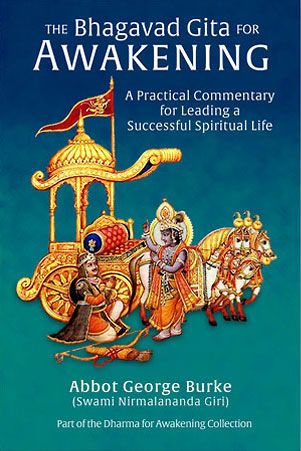
Krishna has told us how not to act, and now will tell us how to act.
Steadfast in yoga, perform actions abandoning attachment, being indifferent to success or failure. It is said that such evenness of mind is yoga (2:48).
Steadfast in yoga, perform actions
The first factor of right action is the all-encompassing factor of fixing the mind and heart in yoga–that is, being constantly engaged in the interior process of yoga whatever the external situation or action. Ultimately it means to do all things with our consciousness united with divine consciousness: God. That is easy to say, but what does it really mean? Krishna is being eminently practical: the only way to act united to divine consciousness is to hold on to that Consciousness through continual immersion in yoga sadhana. “Established in yoga concentration,… he who thinks of me constantly, whose mind never goes elsewhere, for him, the constantly-joined [yoked] yogi, I am easy to attain” (8:12-14). There we have it as easy to see as the oft-cited amalaka fruit in the hand.
Having abandoned attachment
One of the major obstacles in our life is attachment to the fruits of our actions. This, too, will disappear as through interior cultivation our consciousness will turn inward, the inner divine eye will open, and seeing all things in their true nature, the fruits of our actions will no longer seem relevant to us.
Once we have tasted good food, bad food loses all attraction for us. Once we have tasted the Supreme, have touched “the hem of his garment,” external attainments will mean very little–and in time will seem nothing. But this holy indifference can only come from touching the Divine. Mental gymnastics in the form of analyzing objects of desire and recounting their defects is ultimately without worth and is even harmful, for thinking so much about them (even though disparagingly) will attach us to them and draw them to us. “For a man dwelling on the objects of the senses, attachment to them is born,” Krishna will tell us in the sixty-second verse of this chapter.
We detach ourselves from objects by attaching ourselves to God. It is the only way–not just the best or the easiest.
Become indifferent to success or failure
Even-mindedness in success and failure is impossible to achieve by mind-gaming and is in the final analysis worthless. Here, too, it is the fixing of the consciousness on/in God that does the needful. “Keep your mind on me alone, causing your intellect to enter into me. Thenceforward, without doubt, you shall dwell in me” (12:8). When a person dwells in God, what outside success or failure can mean anything to him? What desire or attachment can arise in someone who is united in consciousness to the Source of all?
So often in spiritual life we think of what we should not do, rather than be intent on what we should do. For example, in the consciousness of spirit greed cannot arise. So there is no need to go around telling ourselves: “I must not let greed enter my mind.” Instead we should be intent on remembering God, fixing our mind on Divinity. Then greed will become impossible to us.
It is said that evenness of mind is yoga
Evenness of mind is possible only when the awareness is centered in that which is perfectly stable and still. And that is only a single thing: Spirit. Everything else is changing and therefore unstable and subject to anxiety and compulsion. “Change and decay all around I see. O Thou Who changest not, abide with me,” says the song. But God always abides with and within us. The problem is that we do not abide in the consciousness of God. And this is what is yoga: the uniting (joining–yoga) of our mind with God.
“Lose thyself in him, even as the arrow is lost in the target” (Mundaka Upanishad 2.2.4).
Read the next article in the Bhagavad Gita for Awakening: Right Perspective







